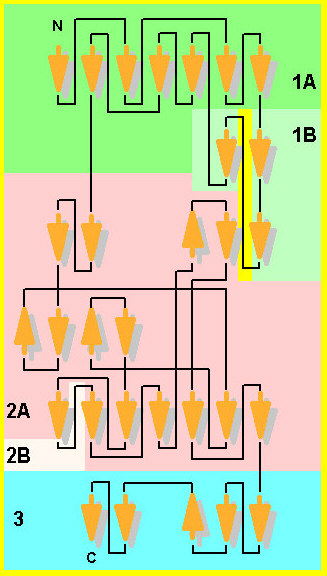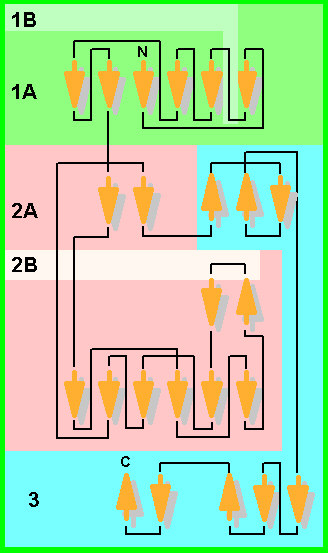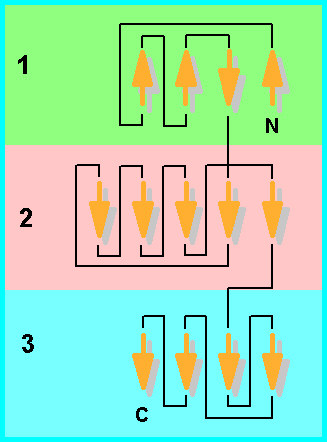RecBCD: processing of DNA breaks
DNA damage is fatal for every living cell unless it is repaired without much information loss. In eubacteria the repair of double strand breaks is accomplished by the homologous recombination pathway. The broken DNA is prepared by partial digestion to a point allowing religation. The initial steps are performed by the RecBCD enzyme, a combination of nuclease and helicase activities. The enzyme digests both strands from the broken end of the damaged DNA until it finds a Chi recognition sequence (Crossover hotspot instigator). From this point only the 5' -> 3'-strand is further digested, leaving the other strand free to interact with RecA-Protein. The RecA filament initiates a recombination event with another p'repaired' DNA-end. Processing of the DNA by RecBCD requires ATP hydrolysis to fuel the reaction.
RecBCD is a heterotrimer of 330 kDa. RecB functions as a 3'-5' helicase and multifunctional nuclease. RecC recognizes the Chi sequence 5'-GCTGGTGG-3' and then limits RecB's nuclease activity to the 5'-3' strand only. RecD works as a helicase in the 5'-3' direction.
The nucleic acid used in the experimental setup was synthesized as a selfcomplementary 43mer . In the X-ray-structure the central unpaired bases T20-T-C-C-C24 are not visible. Residues 5-19 pair with 25-39 to form a regular B-DNA, the rest is already separated and buried in the protein complex . The paired part of the DNA is tightly held by an arm of RecB (use the mouse to turn the view and find the channels for the single stranded DNA!).
The helicase part of RecB
is structurally similar to the helicase superfamily 1.
Domain 1A
contains a central parallel beta-sheet in it's RecA-like structure. Both a
and a
motif are found. The canonical walker A-structure Ala-x-x-x-x-Gly-Lys-Thr
is used to wrap around the phosphate part of a nucleotide and thereby fix it. Next to walker B (here the sequence Val-Ala-Met-Ile-Asp)
Glu385 is the catalytic residue of the ATPase. So this part of RecB
constitutes the engine fueling the helicase activity by hydrolyzing ATP. Domain 1B links the helicase
(bright green) to the arm holding the double stranded DNA
. While domain 1B is structurally similar to corresponding parts of other helicases, the arm is unique to RecB. Within the arm amino acids 289 to 304
are not visible in the X-ray experiment.
The structure of domain 2A
follows the helicase superfamily pattern again. It binds the 3' end of the ssDNA
; together with domain 1A
it constitutes the helicase motor. The all-helical domain 2B protrudes away from the helicase motor and interfaces with RecC
.
A
connects from domains 1A - 1B - 2A - 2B to domain 3, the nuclease
. The structure pattern of this nuclease
is also found in the exonuclease of phage lambda, with conserved amino acids at the catalytic center
. A magnesium ion
is part of the center
.
The figure below shows the overall folding scheme of RecB
with omission of helical areas:

The folding scheme of RecC with it's large parallel stranded beta-sheets strongly hints to it's roots in the helicase superfamily of enzymes like RecB.

The spatial arrangement of the domains however is unique to RecC. There are three gaping holes in the structure. The central cavity is lined by domains 2A and 2B . Plugged into this gap is domain 2B of RecB . The hole formed by domain 3 surrounds the 5'-end of the processed DNA . A pin protruding from domain 3 marks the zipping point for the DNA . In vivo with a "real" DNA the single-stranded 5'-end would extend through the hole towards the second helicase, RecD. The other free DNA end (3') would be longer, too, and pass through the third hole and along the RecB helicase motor into the direction of the nuclease part of RecB (rock the cutaway view with your mouse - you will see the channels in the RecBCD complex!).
The folding scheme of the other helicase subunit, RecD , is only partly similar to the helicase superfamily theme, notably in domain 1, which lacks the large parallel stranded sheet . RecD has (and must have in the context of the whole complex) a reversed directionality with respect to movement along ssDNA. This is attributed to the absence of helicase submotifs in domain 1.

Domains 2 and 3 correspond to the motor domains of other helicases, the ATPase-motifs walker A
and walker B are situated in domain 2 .During operation of the RecBDC complex both single stranded DNA ends are treated by an individual helicase motor. For the digestion of the surplus ssDNA, however, there is only one nuclease present, domain 3 of RecB . The position near to the exit points of the ssDNA strands makes it possible for the nuclease to turn away from RecC and the 3'-DNA end and to face the 5'-DNA end to chew it off.
RecC contains the Chi scanning site, which was tentatively identified by mutagenesis experiments . When these amino acids bind to the recognition sequence 5'-GCTGGTGG-3', further slippage of the DNA towards the nuclease is suppressed. This results in the DNA to bulge out of the protein complex as the RecB helicase works on. In this instance the nuclease is able to digest the other strand only, preparing the staggered ends needed for religation.
this demonstration.
Literature:
MR Singleton et al, Crystal structure of RecBCD enzyme reveals a machine for processing DNA breaks, Nature 432 (2004) 187-193
MR Singleton & DB Wigley, Modularity and specialization in superfamily 1 and 2 helicases, J. Bacteriol. 184 (2002) 1819-1826

